翻译理论与实践 第三节
- 格式:ppt
- 大小:223.00 KB
- 文档页数:22
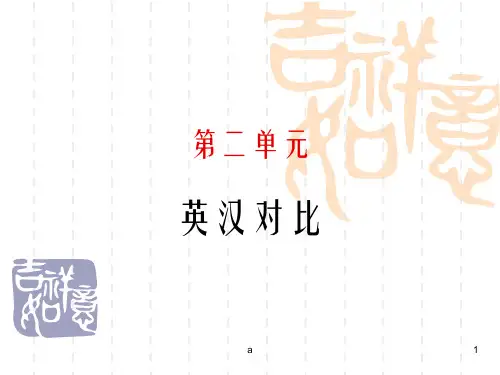
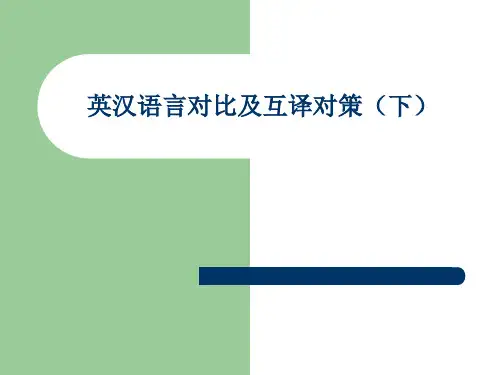
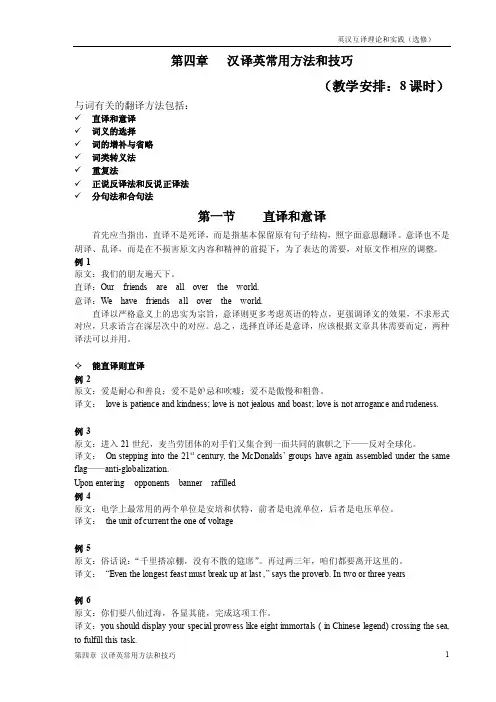
第四章汉译英常用方法和技巧(教学安排:8课时)与词有关的翻译方法包括:✓直译和意译✓词义的选择✓词的增补与省略✓词类转义法✓重复法✓正说反译法和反说正译法✓分句法和合句法第一节直译和意译首先应当指出,直译不是死译,而是指基本保留原有句子结构,照字面意思翻译。
意译也不是胡译、乱译,而是在不损害原文内容和精神的前提下,为了表达的需要,对原文作相应的调整。
例1原文:我们的朋友遍天下。
直译:Our friends are all over the world.意译:We have friends all over the world.直译以严格意义上的忠实为宗旨,意译则更多考虑英语的特点,更强调译文的效果,不求形式对应,只求语言在深层次中的对应。
总之,选择直译还是意译,应该根据文章具体需要而定,两种译法可以并用。
✧能直译则直译例2原文:爱是耐心和善良;爱不是妒忌和吹嘘;爱不是傲慢和粗鲁。
译文:love is patience and kindness; love is not jealous and boast; love is not arrogance and rudeness.例3原文:进入21世纪,麦当劳团体的对手们又集合到一面共同的旗帜之下——反对全球化。
译文:On stepping into the 21st century, the McDonalds’ groups have again assembled under the same flag——anti-globalization.Upon entering opponents banner rafilled例4原文:电学上最常用的两个单位是安培和伏特,前者是电流单位,后者是电压单位。
译文:the unit of current the one of voltage例5原文:俗话说:“千里搭凉棚,没有不散的筵席”。
再过两三年,咱们都要离开这里的。
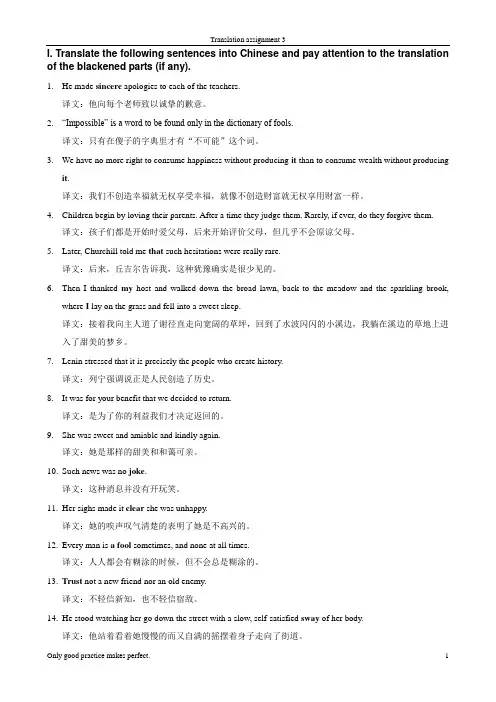
I. Translate the following sentences into Chinese and pay attention to the translation of the blackened parts (if any).1.He made sincere apologies to each of the teachers.译文:他向每个老师致以诚挚的歉意。
2.“Impossible” is a word to be found only in the dictionary of fools.译文:只有在傻子的字典里才有“不可能”这个词。
3.We have no more right to consume happiness without producing it than to consume wealth without producingit.译文:我们不创造幸福就无权享受幸福,就像不创造财富就无权享用财富一样。
4.Children begin by loving their parents. After a time they judge them. Rarely, if ever, do they forgive them.译文:孩子们都是开始时爱父母,后来开始评价父母,但几乎不会原谅父母。
ter, Churchill told me that such hesitations were really rare.译文:后来,丘吉尔告诉我,这种犹豫确实是很少见的。
6.Then I thanked my host and walked down the broad lawn, back to the meadow and the sparkling brook,where I lay on the grass and fell into a sweet sleep.译文:接着我向主人道了谢径直走向宽阔的草坪,回到了水波闪闪的小溪边,我躺在溪边的草地上进入了甜美的梦乡。
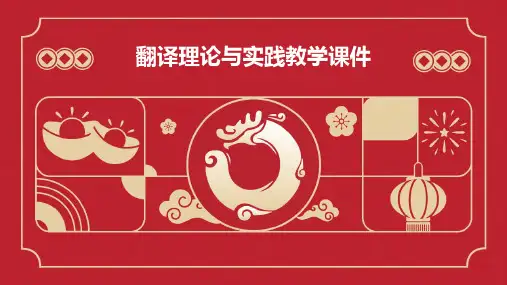
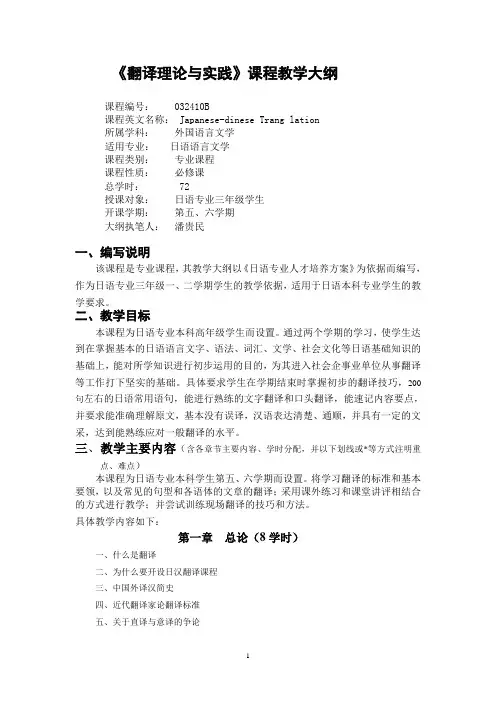
《翻译理论与实践》课程教学大纲课程编号: 032410B课程英文名称: Japanese-dinese Trang lation所属学科:外国语言文学适用专业:日语语言文学课程类别:专业课程课程性质:必修课总学时: 72授课对象:日语专业三年级学生开课学期:第五、六学期大纲执笔人:潘贵民一、编写说明该课程是专业课程,其教学大纲以《日语专业人才培养方案》为依据而编写,作为日语专业三年级一、二学期学生的教学依据,适用于日语本科专业学生的教学要求。
二、教学目标本课程为日语专业本科高年级学生而设置。
通过两个学期的学习,使学生达到在掌握基本的日语语言文字、语法、词汇、文学、社会文化等日语基础知识的基础上,能对所学知识进行初步运用的目的,为其进入社会企事业单位从事翻译等工作打下坚实的基础。
具体要求学生在学期结束时掌握初步的翻译技巧,200句左右的日语常用语句,能进行熟练的文字翻译和口头翻译,能速记内容要点,并要求能准确理解原文,基本没有误译,汉语表达清楚、通顺,并具有一定的文采,达到能熟练应对一般翻译的水平。
三、教学主要内容(含各章节主要内容、学时分配,并以下划线或*等方式注明重点、难点)本课程为日语专业本科学生第五、六学期而设置。
将学习翻译的标准和基本要领,以及常见的句型和各语体的文章的翻译;采用课外练习和课堂讲评相结合的方式进行教学;并尝试训练现场翻译的技巧和方法。
具体教学内容如下:第一章总论(8学时)一、什么是翻译二、为什么要开设日汉翻译课程三、中国外译汉简史四、近代翻译家论翻译标准五、关于直译与意译的争论六、如何学好日译汉及初学者常犯的毛病(一)不断提高日语水平——理解方面常见错误(二)提高中文水平(三)善于使用工具书七、翻译文章的具体步骤第二章句子的译法(14学时)第一节移位法——单句的翻译(一)主语的移位(二)客语的移位(三)用修——补语的移位第二节拆句法——复句的翻译(一)长连体修饰句的拆译(二)长连用修饰句的译法(三)长并列句及复杂句的译法第三节加译与减译(一)加译(二)减译第四节改变成分法第五节合并句子法第六节语言凝练法(浓缩法)1、目的2、什么是凝练法3、如何凝练第三章词的译法(14学时)第一节翻译中修辞的必要性第二节选词的方法(一)注意上下文的逻辑关系(二)注意作者的立场(三)选词要符合环境、气氛(四)选词应注意文章体裁(五)注意语言的时代性第三节词语的具体化与概括化第四节词语的反译法第五节把握中文词的含义第四章文章的翻译(30学时)一、贸易信函的翻译二、贸易信函翻译练习三、报刊文章的翻译四、论说文的翻译1、注意事项2、论说文选(一)科学者と頭(二)国際環境と日本五、随笔的翻译1、注意事项2、随笔文选(一)光陰矢の如し(二)こわい先生たち(三)北の森から(四)沈黙の世界(五)河豚(六)おふくろ(七)人生は変幻の猫(八)おそれという感情六、小说的翻译(一)青い壶(二)絵本(三)転落の詩集第五章练习题参考答案及译文(2学时)五、教材(名称、作者、出版社、出版时间)《新编日汉翻译教程》,庞春兰编著,北京大学出版社,1998年3月。

第一章英汉文化对比与翻译有一则趣谈:一所国际公寓闹火灾,里面住有犹太人,法国人,美国人和中国人.犹太人急急忙忙先搬出的是他的保险箱,法国人先拖出的是他的情人,美国人则先抱出他的妻子,而中国人则先背出的是他的老母.一、文化的定义文化是指人类社会历史实践过程中所创造的物质财富,精神财富和相应的创造才能的总和。
文化包括物质文化与精神文化,物质文化是指文化中看得见,摸得着的那部分,因此也称之为硬文化.相对来说,精神文化就是软文化,而软文化则是文化的深层结构。
美国著名翻译理论家尤金.奈达将语言文化特性分为五类:Ecological Culture 生态文化Material Culture物质文化Social Culture社会文化Religious Culture宗教文化Linguistic Culture语言文化二.中西方文化差异(一)西方重唯理,思辩,中方重经验,直觉(二)西方的细节分析与中方的整体综合(三)中西方价值观与人生追求的不同三、文化影响翻译的表现形式:(一)词汇空缺现象(Zero of equivalent word)在一种语言里的有些词在另一种语言里没有对等或契合的词,有人称这种情况为词汇空缺(lexical gap) Salad沙拉Lost Generation迷惘的一代Beat Generation垮掉的一代Baby Boomers生育高峰儿婴儿潮一代Y uppies雅皮士Dinks丁克Sandwich Generation三明治世代Couch Potato电视迷老泡在电视机前的人;终日懒散的人Mall Rats购物狂Hippie嬉皮士功夫kongfu叩头kowtow 炕Kang太极Taichi粽子Zongzi苦力Kuli饺子jiaozi 还有一些民族文化内涵特别丰富的词语,在翻译时也必须采用释义或注释等方法,说明该词的语用含义,才能使译语读者了解原语独特的文化现象。
如:钱先生周岁时“抓周”,抓了一本书,因此得名“钟书”。
![翻译理论与实践[汉译英]3.2语境与词汇的翻译](https://uimg.taocdn.com/c6bd6d7ac281e53a5902ff51.webp)

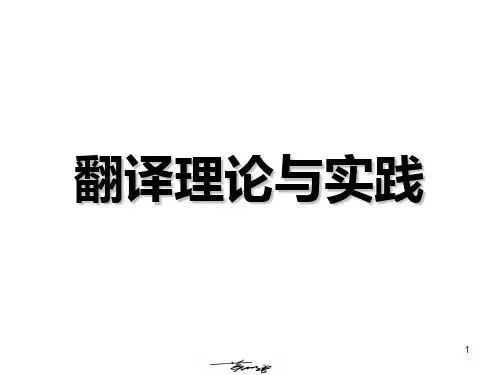
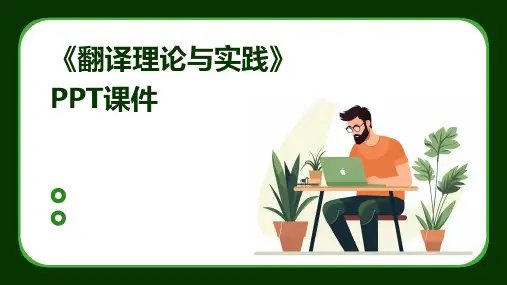
翻译理论与实践3一. 单选题(共10题,共6分)1. In the years that followed, Bill learned to spell in this uncomprehending way a great many words. (0.6分)A.在以后的岁月里,比尔就这样学着拼写,并且学会了拼写许多单词,真叫人难以理解。
B.在往后的几年里,比尔就这样学着拼写,虽然不理解意思,却也学会了拼写许多单词。
C.在尔后的年月里,令人不解的是,比尔就这样学着拼写,居然也学会了拼写许多单词。
D.令人不理解的是,在往后的日子里,比尔就这样学着拼写,而且学会了拼写许多单词。
☆考生答案:B★考生得分:0.6 分评语:2. There is supposed to be a safety ______ which makes it impossible for trains to collide. (0.6分)A. applianceB.accessoryC.machineD. mechanism☆考生答案:D★考生得分:0.6 分评语:3. It would have been difficult to find a happier child than I was as I lay in my crib at the closeof that eventful day and lived over the joys it had brought me. (0.6分)A.在这个意义重大的日子即将结束的时候,我躺在小床上,沉浸在快乐之中,恐怕再也找不到比我更幸福的孩子了。
B.在这个意义重大的日子即将结束的时候,我躺在小床上,生活在快乐之中,我比任何孩子都幸福。
C.恐怕再也找不到比我更幸福的孩子了,就在这个意义重大的日子即将结束的时候,我躺在小床上,沉浸在快乐之中。
D.我比任何孩子都幸福,就在这个意义重大的日子即将结束的时候,我躺在小床上,生活存快乐之中。
《翻译理论与实践》课程教学大纲一、课程基本信息课程名称:翻译理论与实践英文名称:Theoryand Practice of Translation课程编号:0311021B课程类别:专业主干课程总学时:32总学分:2开课学期:第五(六)学期适用专业:英语专业先修课程:无二、课程性质与任务《翻译理论与实践》为英语专业本科教学中的一门主干课程,通过本课程的教学,帮助学生有效提高翻译的理论知识和实践能力,达到高等学校英语专业教学大纲对其翻译能力的基本要求,即:能运用翻译理论和技巧,对翻译的基本理论达到理解和应用,用理论指导实践使得译文忠实流畅,并能胜任涉及翻译能力的工作。
三、课程教学目标本课程是为英语专业学生开设的专业知识课程。
该课程具有针对性、分析性和可操作性,先总体介绍翻译所涉及到的基本理论,后从翻译与文化、翻译方法及策略等方面入手逐一分解。
从而增加学生的翻译知识储备,培养学生的翻译理论素养和翻译实践能力。
使学生了解翻译的源流,培养学生探究翻译理论、动手翻译的实践能力。
提高学生逻辑思维和独立思考的能力;提升学生的专业素质,拓宽学生的知识面,为进一步的学习打好基础。
四、教学方法与手段教学中采用教师为主导、学生为主体的教学模式,讨论式、发现式和研究式的教学方法,引导学生勤于思考,培养学生的鉴赏和表达能力。
在教学中,开展以任务为中心的、形式多样的教学活动。
在加强翻译训练的同时,采用启发式、讨论式、发现式和研究式的教学方法,充分调动学生学习的积极性。
充分利用现代化的教学手段,开发新的教学资源。
五、考核方式1.考核方式:考查2.过程性考核和期末考试相结合考试范围涵盖所讲授的《翻译理论与实践》相应课程的全部内容。
过程性考核包括考勤、课堂表现、作业。
最终成绩由平时成绩(20%)和期末考试成绩(80%)按一定比例折算后以百分制计。
六、课时分配七、教学内容第一章翻译导论(4学时)【教学目标】1.明确翻译的定义2.熟悉翻译的本质3.了解翻译的起源和意义【教学内容】1.关于翻译的比喻2.翻译的定义3.翻译的起源和意义【教学重点】1.从关于翻译的比喻入手,了解翻译的本质2.从《巴别塔的故事》中了解翻译的起源和意义【教学难点】从语言学、文化、文学、交际学、语义学等层面剖析翻译的定义【学时数】1.课堂讲述2学时2.课堂讨论、习题讲解2学时第二章翻译的分类(2学时)【教学目标】1.熟悉不同层面上翻译的分类方式2.明确每种分类的原则和基本内容3.掌握每种分类方式的区别与联系【教学内容】语言、语言符号、翻译模式、源语文体和翻译变体等五种层面上翻译的分类【教学重点】1.语言、语言符号、翻译模式、源语文体和翻译变体等五种层面上翻译的分类2.每种分类的原则和基本内容【教学难点】对文学翻译和非文学翻译的要求的区别【学时数】1.课堂讲述1学时2.课堂讨论、习题讲解1学时第三章翻译的原则和标准(4学时)【教学目标】1.明确掌握中西方翻译学者所提出的各种翻译标准和原则2.比较中西方翻译学者所提出的翻译标准和原则的区别与联系【教学内容】1.中国翻译学者提出的翻译标准和原则2.西方翻译学者提出的翻译标准和原则【教学重点】中西方翻译学者所提出的各种翻译标准和原则,如严复的“信、达、雅”、泰特勒翻译三原则、奈达的功能对等【教学难点】对比两种翻译原则的异同,如严复的“信、达、雅”与泰特勒的三原则【学时数】1.课堂讲述2学时2.课堂讨论、习题讲解2学时第四章译者的素质(2学时)【教学目标】1.了解译者的责任2.熟悉译者应具备的素质3.了解口译员应具备的特殊素质【教学内容】1.译者的技术责任及社会和文化责任2.译者的素质3.口译员的特殊素质【教学重点】1.译者普遍应具备的素质,如思想政治素质、职业道德、系统知识储备及合理的应用能力等2.口译员应具备的特殊素质【教学难点】译者普遍应具备的素质,如思想政治素质、职业道德、系统知识储备及合理的应用能力等【学时数】1.课堂讲述1学时2.课堂讨论、习题讲解1学时第五章翻译的过程(6学时)【教学目标】1.明确了解关于翻译过程几种观点,并掌握奈达与贝尔的观点2.重点掌握翻译的过程、理解的特点、理解与表达的关系及校对的内容【教学内容】1.西方的几个翻译过程模式2.翻译过程的三步骤【教学重点】1.翻译过程的三步骤2.尤金▪奈达关于翻译过程的代表观点3用心理语言学及诠释学的理论解释翻译过程【教学难点】翻译过程中理解与表达的关系【学时数】1.课堂讲述3学时2.课堂讨论、习题讲解3学时第六章中西翻译理论发展及现状(4学时)【教学目标】1.了解中西翻译史2.了解中西翻译理论发展及现状3.了解中外著名翻译理论家及其翻译思想【教学内容】中国翻译简史西方翻译简史中西方翻译理论研究现状【教学重点】1.中西方翻译高潮2.中外著名翻译理论家及其翻译思想【教学难点】中西方著名翻译理论家及其翻译思想【学时数】1.课堂讲述2学时2.课堂讨论、习题讲解2学时第七章翻译与文化(6学时)【教学目标】1.了解翻译中文化因素的渗透2.了解翻译中文化的差异及转换【教学内容】1.汉英翻译与文化2.中英思维方式对比3.汉英语言对比【教学重点】1.语言与文化的密切关系2.中西方语言文化差异3.翻译中的文化转换【教学难点】1.汉英语言对比2.翻译中的文化转换【学时数】1.课堂讲述3学时2.课堂讨论、习题讲解3学时第八章直译与意译(2学时)【教学目标】1.了解直译与意译的含义2.了解直译与意译的功能3.了解翻译中直译与意译相结合的方法【教学内容】1.直译与意译的定义2.直译与意译的特点、功能、冲突与协调3.直译与意译的适用条件【教学重点】1.直译与逐字译的区别2.意译的含义3.直译与意译的功能【教学难点】直译与意译的功能及适用条件【学时数】1.课堂讲述1学时2.课堂讨论、习题讲解1学时第九章归化与异化(2学时)【教学目标】1.了解归化与异化的概念及其历史沿革2.正确认识翻译中的归化与异化问题3.学会在翻译实践中恰当运用归化与异化策略【教学内容】1.归化与异化的概念2.“归化”与“异化”同“直译”与“意译”的异同3.技术层面上的归化与异化处理【教学重点】1.归化与异化的概念及其历史沿革2.学会使用归化和异化的翻译策略【教学难点】在翻译实践中恰当运用归化与异化策略【学时数】1.课堂讲述1学时2.课堂讨论、习题讲解1学时八、教材及主要参考书[1]Newmark,P. .A Textbook of Translation. Shanghai: SFLEP, 2001.[2]Nida,E. A. Language, Culture, and Translating. Shanghai: SFLEP, 1993.[3]Nida,E. A. Language and Culture: Contexts in Translating. Shanghai:SFLEP,2001.[4]陈宏薇. 新实用汉译英教程. 湖北:湖北教育出版社.2000.[5]冯庆华. 实用翻译教程(英汉互译. 上海:上海外语教育出版社.2002.[6]姜倩,何刚强. 翻译概论. 上海:上海外语教育出版社.2008.[7]谢天振,何绍斌. 简明中西翻译史. 北京:外语教学与研究出版社.2013.。
翻译理论与实践(Translation theory and Practice)This paper consists of the 8888 contributionPpt documents may experience poor browsing on the WAP side. It is recommended that you first select TXT, or download the source file to the local view.Translation theory and PracticeI., What, is, translation, II., Is, it, to, translate, easy, III.,, Can, all, the, translated, words, be?I., What, is, translation?1, the definition of translation? 2, translation is to translate the text or? E.g.1:, My, sister, went, to, school, at, 7., e.g.2:, have you eaten? Where to? E.g.3: you're beautiful today! -- where?!II., Is, it, easy, to, translate?Henchman? Go back to man in the? The? Street? Crow s feet a hen party '? Fog lock hill mountain fog water disappears in the sky with rain window, two East West three point cut to carve up the piece, seven horizontal eight vertical knife knife toward the sea towards towards falling towards long clouds long long.III., Can, all, the, words, be, translated?According to the nephew lanterns (old uncle)? East sunrise rain, is (clear) the situation is a (clear)? --The professor shouted:Gentlemen, order --The entire class yelled:! "" Beer! "--Why is the river very? Rich? --Because it has two banks.You can cage a swallow, but you can t swallow a "cage. --The secret is going to? Be exposed, and we ll look pretty silly. --You" already look pretty and silly. bathing on bikini? Girl, eyeing, boy, finds boy eyeing bikini on bathing girl.Chapter 1The definition of translation, the purpose of translation, the type of translation, the standard of translation, the process of translation, the conditions for translationDefinition of translationTranslation is the practice of language in which the content of another language is re expressed in one language. Feng Qinghua? Translation is a kind of language (i.e., primitive) information in another language (the target language) express, so that the readers can get the original thoughts expressed by the author, are roughly the same as the original readers feel. - Fan Zhongying, translation is the translator's re understanding of the same thing and the use of another text. - Qiao HaiqingDefinition of translationTranslation is "an interpretation of verbal signs by means of some other language Translation is." Jakobson? "The replacement of textual material in one language (SL) byequivalent textual material in another language (TL). Catford Translation is the replacement of? A representation of a text in one language by a representation of an equivalent text in a second language. HudsonThe purpose of translationA bridge of communication and communication between different languages and cultures.Types of translationIntra language translation (intralingual translation) an interpretation of verbal signs by means of other signs in the same language (interlingual translation) translation? An interpretation of verbal signs by means of some other language? Intersemiotic translation (intersemiotic translation) an interpretation of verbal signs by means of nonverbal signs systemChinese translation theoriesYan Fu: Xindaya translation - Three: xindaya. It is hard to ask for a letter. Take care of the letter and fail to reach it,Even if you do not translate it, you will also interpret it. ? Lu Xun: faith, Shun - a course to make it easy, one is to preserve the original charm. / / faith rather than fluency? Qu Qiubai: the notion of equivalence translation should be the original intention, exactly China introduced to readers, make readers get China concept concept equal to other language from the textto the reader. Contradiction: to reproduce the artistic conception the highest task of literary translation is to reproduce the artistic conception so that the target readers can enjoy the beauty as much as the original.Chinese translation theoriesLiu Zhongde: letter, reach, cut letter: believe in content: as long as it is cut: to adapt to style, Zhang today: true, good, beautiful, truth: truth, principle, good: ideological principles: Beauty: artistic principlesForeign translation theoriesTytler: 1. The translation should the same effect on give a complete transcript of the ideas of the original work. style and manner of 2. The writing should be of the same character as that of the original. translation should have all 3. The the ease of the original composition.Federov: on Translation should produce a translation version which may be read with as much pleasure as the original, and yet remain faithful to its spirit, sense and style. Nida: dynamic equivalence theory readers get responses, and feelings with the original readers read the original income roughly equal. Newmark: text centered theoryProcess of translationIt is generally believed that the original text is understood expression Nida: original text testAnalytical translationTarget textRestructureFour steps: analysis, translation, reconstruction, testTranslation, from, English, to, Chinese:1., The, days, run, into, weeks., the days go by, for a few weeks.2. It, s, all, Greek, to, me., the translation condition, I do not understand at all. Mandarin Chinese is better than3. Mary has? A clever tongue. Marie (glib glib). English language ability is better than4., You, can, never, tell., wide knowledge, no one can say.5., My, memory, failed, me, at, that, moment., I can't remember that moment.6., Your, name, obstinately, escapes, me., I can't remember your name.7., To, think, that, you, should, fail., I don't think you will fail. 8., Would, it, were, otherwise, if that's not the case. There was more mischief than harm in him. he is only mischievous, and no harm. 10., I, never, go, past, my, old, school, but,, think, of, our, headmaster.. Every time I pass my alma mater, I remember our headmaster. 11., The, book, is, beyond, me., I can't read this book. 12., There, is, nothing, like, leather, for, shoes., leather shoes are great. 13., It, is, too, recent, to, be, forgotten., fresh in memory.14., The, mountain, is, not, valuable, because, it, is, high.,mountain is precious, not at its height. The "This is the last place I where expected to meet you." did not expect to meet you here. 16., He, is, nothing, if, not, stubborn., he's a stubborn man. 17., I, was, not, a, little, surprised., I was shocked.18., He, can, do, it, if, any, one, can., only he can do it.19. You cannot make something out of nothing. one can't make bricks without straw. 20., I, can, t, bear, the, sight,, of, that, man.I can't stand seeing that man.Similar sentences1. He had made a box., he has made a box. He had a box made., he told people to make a box.2. Foolishly he spoke. he was so foolish to speak. He spoke foolishly. he talks very stupid.3. Quite properly he was punished. he deserved to be punished. He was punished quite properly., he was properly punished.4., We, asked, him, to, speak, from, his, experience., we ask him to talk about it based on his experience. We asked him to speak about his experiences. we asked him to talk about his experience.Similar sentences5. He is behind time. he's late. He, is, behind, the, times., he's behind the times.6. His success is out of question. his success is beyond doubt. His, success, is, out, of, the, question, he's never going to be successful.7., They, went, to, sea., they're going to besailors. They, went, to, the, sea., they went to the beach. 8., It, has, been, raining, continually, for, two, days., rain, intermittent two days. It has, been, raining, continuously, for,, two, days rain continued for two days.Similar sentences9., He, has, no, more, than, ten, books., he has only ten books. He has not more than ten books., he has ten books at most.He is not a little afraid of it. he was very scared. He is not a bit afraid of it., he is not afraid at all. 11., I, didn, t, go, because, I, was, afraid., I am not afraid to go. I, didn, t, go, because, I, to., was, afraid, I did not go, because I dare not go. 12. She kept the house., she watches over the house. She kept house. her home.Similar sentences13., This, is, no, place, for, me, to, go., this is not whereI should go. There, is, no, place, for, me, to, go, I have nowhere to go. 14. I, had, a, good, talk, to, him, yesterday., I gave him a good dressing down yesterday. I had a good talk with him yesterday. I had a really good time talking to him yesterday. 15., Tom, escaped, prison., Tom escaped the jail. Tom, escaped, from, prison., Tom, jailbreak. 16., Is, there, any, difficulty, in, this? Do you have any difficulty with this? Is, there, some, difficulty, in, this? It's a bit difficult, isn't it?Similar sentencesWe are sure that man is mortal. we are sure that man will always die. We, are, sure, that, man, is, dead., we are sure the man is dead. 18., We, hired, the, boat, by, the, hour.. We ship by hour. We hired, the, boat, for, an, hour., we rented an hour boat.Similar sentences19., I, did, not, notice, him., I didn't notice him. I, took, no, notice, of, him., I don't care about him. 20., Happily, he, did, not, die., thankfully he did not die. He did not die happily., he died uneasy.The second chapter is semantic translationFirst, the choice of meaning in the understanding of polysemy (polysemy)The translation of runRun, a, car, run, shop, run, oil, run, message, a, fever, run, a, computer, run, run, a, meeting, run,, chickens, run, a, arms, advertisement, run, anHead translation10. He arranged his speech under five heads. his speech is divided into five parts. 11., We, have, thirty, head, of, cattle.We have thirty cows. 12., Heads, or, tails? Heads or tails? 13., Where, is, the, head? Where is the toilet?The translation of head:1. head of the English Department, director of the English Department of2. head of the government head of the bed, head of government3.4. head of the staircase a of the needle at the top of the stairs5. head6. He was badly wounded in a the head. he was badly wounded in the head.7. He has a good head for maths. he has a lot of mathematical talent.8., You, should, use, your, head., you should use your head.9. The, dinner, cost, US, five, dollars, a, head., the meal cost us 5 yuan each.The translation of I. poor:1. The, cloth, is, poor, in, quality., this cloth is of poor quality.2. The, water, is, poor, in, oxygen., this water is anoxic.3. Her first concert had a poor audience., her first concert, with very few listeners.4. This, to, her, was, a, poor, consolation., this comfort does not work for her.5. In my poor opinion, you should let her go. in my humble opinion, you should let her go. Boat. She was a poor sailor and always went to bed immediately on on getting the she has seasickness problems, so always go to bed on board.The translation of II. runThe He will not be running in the next election., he is not ready to run for the next election. 2., The, train, is, not, running, today., that train is off today. 3. The film began to run. filmat the. 4. His face was running with sweat. he Sweat streamed down the face. 5., It, was, such, a, ran., hot, day, that, the, butter, the weather was so hot that the butter melted. 6., The, road, runs, north., this road extends north. The "The rumor runs that he is going to resign." is rumoured that he is going to resign. 8., The, monsoon, had, six, weeks, more, to, run., the rainy season will last six weeks.The translation of II. run9., The, car, repair, will, run, you, at, least, two, hundred., repair, at least you spend two hundred yuan. 10. The play ran for only a week in that theatre.. The play was only staged for a week in that theater. 11., Potatoes, are, running, large, this, year., potatoes grow a lot this year. 12., A, freezer, doesn, run., t, cost, much, to, the use of the refrigerator is not very expensive.The translation of III. liveShe needs to find somewhere to live. she needs to find a place to live. 2., Where, do, these, plates, live? Where are these dishes? 3., Spiders, can, live, for, several, days, without, food., spiders can live without food for a few days. 4., We, saw, a, real, rattlesnake, live! We saw a live rattlesnake.The translation of III. live5. The club has live music most nights., the club has live music most nights.6. The show is going on live., the show is being broadcast live.7., Pollution, is, still, very, much, a, live,issue. pollution is still a very interesting issue at the moment.8., This, is, a, live, and, interesting, book., this is a lively and interesting book.The translation of IV. like1., He, likes, mathematics, more, physics., than, he prefers mathematics to physics.2., Bananas, don, t, like, me., I ate a banana and my stomach was upset. (bananas do not fit my stomach.) Three它的味道像芒果。